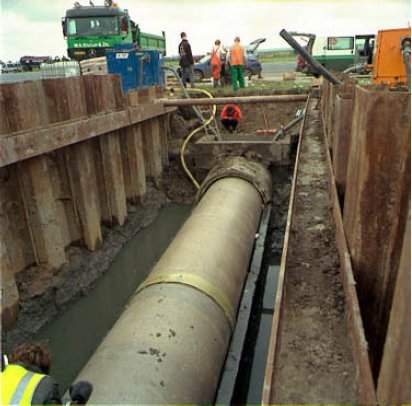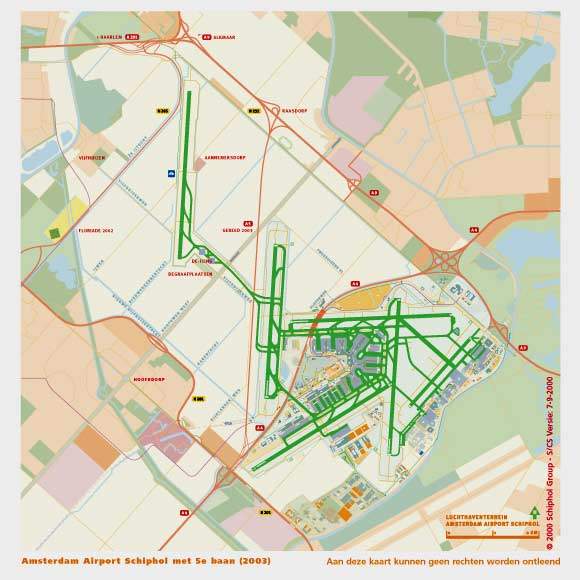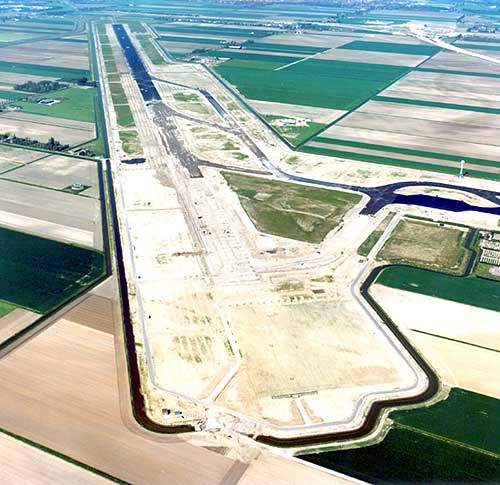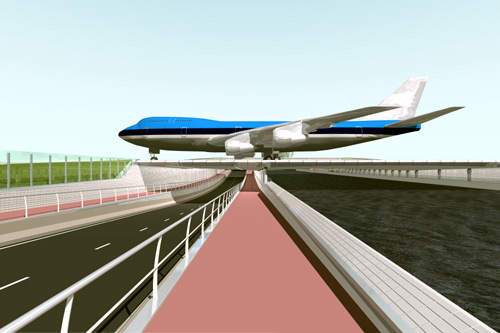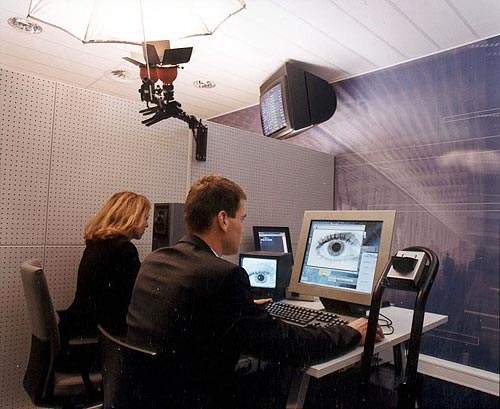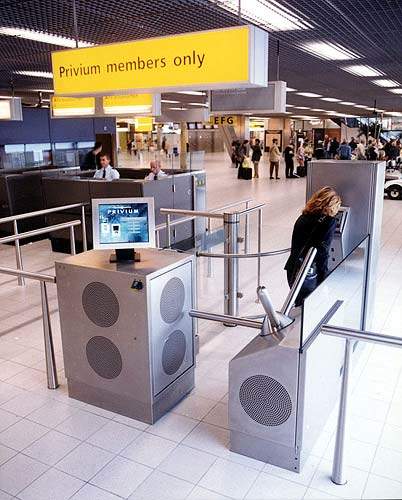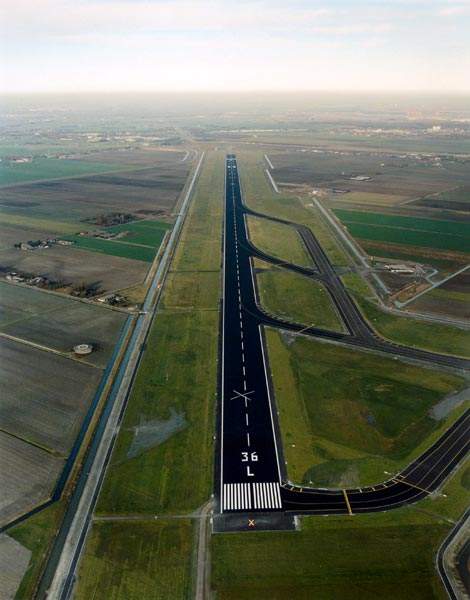The expansion plans at the Amsterdam Airport Schiphol included the new fifth runway, Polderbaan, opened for operation at the end of February 2003, as well as the renovation of Departure Lounge 1, which opened in 2005. The plans also involved the innovative automatic border passage system that uses iris recognition, enabling quick and secure border passage.
Schiphol Group invested €340m in the new fifth runway, and €165m in Departure Lounge 1.
The Schiphol Group signed a €175m loan agreement with the European Investment Bank in April to fund the proposed construction of a new terminal and a new pier at the airport by 2024.
Contractors and financing for fifth runway
The first plans for the fifth runway were presented in 1970. In 1995, the Dutch Parliament ratified its government white paper on the ‘Future of Schiphol’, which allowed the construction of Schiphol’s fifth runway, with the condition that the noise level in the airport surroundings does not increase.
The contractors involved in the construction of the runway were Vermeer Infrastructure, Ballast Nedam Grond en Wegen and Heijmans Infrastructure en Mileu.
Koninklijke Wegenbouw Stevin was contracted to dig the drainage ditches and construct the service roads around the construction area.
ARCADIS performed several functions during the airport expansion project.
To allow for the extra traffic entering and leaving the airport complex, a three-lane tunnel and a two-lane tunnel were constructed. ARCADIS undertook much of the construction of these tunnels.
During 2002, runway 09-27 was closed for two weeks in order to carry out renovations to the rainwater sewage pipes located under the runway. BAM HBG Civiel BV was the main contractor, and HOBAS supplied the replacement piping.
The EU’s long-term financing institution, the European Investment Bank, lent Schiphol €150m for the construction of the fifth runway and associated taxiways.
Air traffic growth and noise levels
Construction of the fifth runway at Amsterdam Airport Schiphol started in September 2000.
The Polderbaan runway was designed to support the expected growth of air transport movements. The new runway was also intended to eliminate noise disturbance in the airport environs.
The taxiway became operational at the end of February 2003. The opening of the new runway coincided with the revised Aviation Act, effective from January 2003, which incorporated new environmental and safety standards.
The runway is completely operational in all weather conditions and is only used into and from the north. Overall noise disturbance in the area has been reduced due to the approach and departure routes passing over areas with relatively low population density.
Runway dimensions
Polderbaan is Schiphol’s longest runway, measuring 3,800m-long and 75m-wide. It is designed to accommodate super jumbos such as the A380.
Polderbaan is located 2,100m north of the 01L-19R runway, Zwanenburgbaan. The northern tip of the runway is approximately 7km from the Amsterdam Schiphol Airport control tower.
The main taxiway, which connects the new runway with the existing 01L-19R Zwanenburgbaan runway, crosses a main waterway in the Schiphol area by means of a viaduct.
Runway construction materials
A total of 500,000m³ of soil was used in the construction of the new runway, as well as 650,000m³ of sand, which was used to compact the marshy soil and for the first layer of the runway. 750,000t of foundation material was also used, along with 270,000t of asphalt, 130km of drainage, 34km of cabling cylinders, 170km of cables for lighting, and 500 concrete wells to connect cabling and equipment.
The construction also incorporated 1,700 fittings for runway lighting, 20,000l of paint for approximately 67km of runway lines and 906m² of markings. 30km of sewage pipes for drainage, 3km fencing and, 500,000 transport movements were also used.
Departure lounge 1 renovation
The plans for the renovation of Departure Lounge 1 were approved on 4 September 2002, while the expansion project was completed in 2005.
Expansion of the western wing has resulted in a total of 112 arrival/departure gates.
The airport now has the capacity to deal with 60 million passengers a year. Previously, ground handling facilities could only cope with 45 million passengers.
Architectural companies Benthem Crouwel and NACO undertook the design of this renovation. They incorporated ‘Run, Fun and Surprise’ elements. ‘Run’ provides the basic shopping essentials expected at an airport, ‘Fun’ offers entertainment in the form of cafes and restaurants, and ‘Surprise’ allowed for the installation of casinos and coffee corners en route to airplane boarding gates.
Working on the basis that Schiphol is a city in its own right, the designers incorporated a Square and a Street inside the departure lounge. The Street is lined with shops while the Square has shops, cafes and restaurants.
During this renovation, Aggreko supplied temperature control equipment in the form of three 100kW chillers and two air-conditioners of 150kW each.
To help expedite passenger movements, the airport now uses ts.com’s online pre-booking service, ticketingsolutions, for booking long-stay car park reservations.
Automatic border passage using Iris recognition
The automatic border passage system, which uses iris recognition, has become a permanent facility at Schiphol.
Launched in October 2001 as a one-year pilot programme, the automatic border passage was developed by Schiphol Group in close cooperation with the Koninklijke Marechassee Dutch Border Police and the IND.
It is the first large-scale application of biometric identification in the Netherlands and was extensively tested during the pilot programme.
Passengers with passports from countries in the European Economic Area (EEA), otherwise known as the Schengen Countries, as well as Norway, Liechtenstein and Iceland, are able to become Privium members and use the automatic border passage system.
Pilot programme
Schiphol Group, the IND and Dutch Border Police worked in close affiliation to test the system’s operation and effectiveness during the pilot programme.
Dutch technology research institute TNO evaluated the reliability of the system to allow access to the correct individuals, as well as meet all eye safety standards.
TNO’s Physics and Electronics Laboratory (TNO-FEL) worked together with Britain’s National Physical Laboratory during the evaluation.
TNO evaluated the operation of the automatic border passage system using iris recognition. Its British counterpart completed a similar exercise with a system installed in its laboratory.
It was concluded by both institutes that the iris recognition system featured in the Privium programme is extremely reliable and exceeds all eye safety standards.
Biometric identification
The Dutch Ministry of Justice approved Schiphol Group’s continued employment of the automatic border passage system. It has now become a permanent airport facility and a permanent feature of the Privium service programme.
The system is considered the most reliable form of biometric identification. In a list of the greatest scientific achievements over the past 50 years compiled by a panel of leading British scientists to mark Queen Elizabeth II’s golden jubilee, the system at Schiphol was elected the innovation for the year 2002.
Privium Plus and Basic programmes
The passport system is the key feature of Schiphol Group’s Privium service programme designed for frequent travellers. It is both secure, as well as quick.
Members of the programme are guaranteed priority parking in the P2 airport car park, adjacent to the terminal, as well as the entitlement to check-in at dedicated check-in counters when flying with one of the participating airlines.

